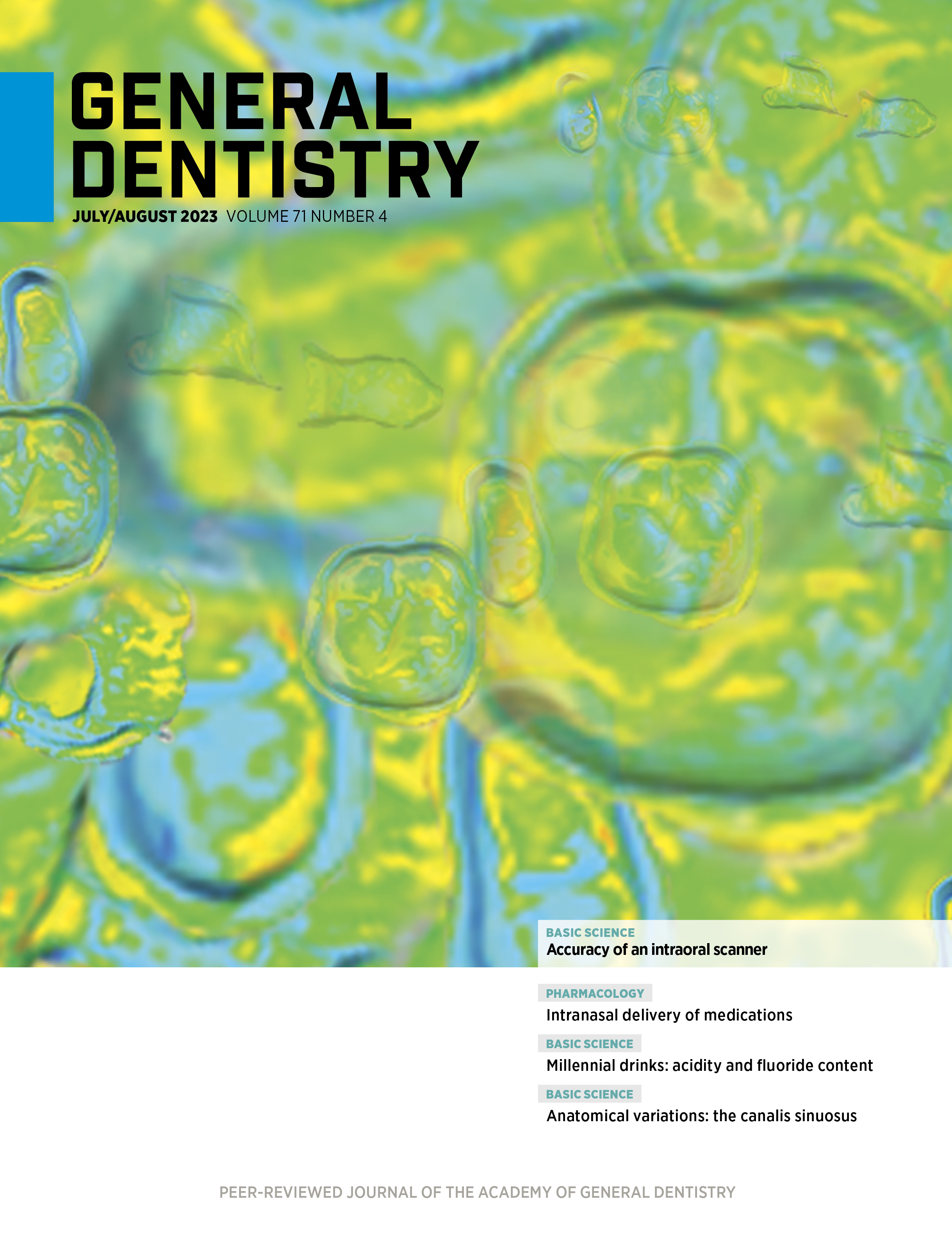-
SELF-INSTRUCTION
Basic Science
Anatomical variations in the maxillary anterior region: a cone beam computed tomographic study of the canalis sinuosus and its accessory canals
Matheus Chaves Veronezzi
Igor Henrique Silva Pinheiro
Elen de Souza Tolentino
Camila Camarini
Wilton Mitsunari Takeshita
Lilian Cristina Vessoni Iwaki
Mariliani Chicarelli da Silva
This study determined the presence of the canalis sinuosus (CS) and any accessory canals (ACs) in 398 cone beam computed tomographic images and assessed for any significant differences according to sex, age, and facial pattern. The CS was identified in 195 patients (48.99%), 165 (84.61%) of whom showed ACs. The CS diameter was significantly higher in male than female patients, but no other statistically significant differences were found based on patient sex, age, or facial pattern.
2023 July/August; 71(4):16-22.
Full Article (PDF)
Self-Instruction Exercise No. GD513
-
SELF-INSTRUCTION
Basic Science
Fatigue resistance of polymeric restorative materials: effect of supporting substrate
Júlia Cadorim Facenda
Márcia Borba
Paula Benetti
Alexandre Luiz Souto Borges
Mauro Dal Zot Dutra
Pedro Henrique Corazza
This study compared the survival rates of polymer-infiltrated ceramic network (PICN) and indirect composite resin (IR) structures when cemented to substrates with different elastic moduli (E). PICN structures showed the best survival rates with the higher E substrate, and IR structures with the low and intermediate E substrates.
2023 July/August; 71(4):24-29.
Full Article (PDF)
Self-Instruction Exercise No. GD514
-
Oral and Maxillofacial Surgery
Solitary intraosseous myofibroma: a rare case diagnosed from mandibular fracture
Lívia Marques dos Santos
Yuri de Lima Medeiros
Beatriz Guimarães Souza
Kelly dos Anjos Melo Pereira
Daniel Amaral Alves Marlière
This case report presents the case of an adolescent patient with an intraosseous myofibroma, discovered incidentally when a physical assault resulted in mandibular fracture. Treatment involved enucleation and curettage of the lesion, fixation of the fracture with osteosynthesis plates, and removal of an impacted third molar.
2023 July/August; 71(4):31-35.
Full Article (PDF)
-
Basic Science
Millennial drinks: acidity, fluoride content, and enamel softening
Sarah Pierce
Arianna Amini
Daranee Tantbirojn
Antheunis Versluis
Mojdeh Dehghan
Hassan Almoazen
This in vitro study aimed to evaluate the acidity and fluoride content of beverages commonly consumed by millennials and the enamel-softening effect of these drinks on tooth enamel. All tested beverages were acidic and had a pH below 4.5; only some contained fluoride. Flavored sparkling water caused less enamel softening than the tested energy drink and kombucha, likely due to the higher pH of the water.
2023 July/August; 71(4):36-43.
Full Article (PDF)
-
Oral and Maxillofacial Surgery
Removal of mandibular third molars displaced to deep fascial spaces: case reports
Felipe Varjão de Sá Carvalho
Paulo Almeida Júnior
Edvaldo Dória dos Anjos
Yohanna Mayanne Lima do Nascimento
Caio Feitosa dos Santos
Luiz Evaristo Ricci Volpato
This article reports 2 cases in which a mandibular right third molar was displaced to deep fascial spaces during attempted extraction. Cone beam computed tomography was used to obtain 3-dimensional visualization of the displaced molars to facilitate surgical intervention. After the molars were removed, both patients healed without complications.
2023 July/August; 71(4):44-47.
Full Article (PDF)
-
Basic Science
Accuracy of an intraoral scanner based on sleeve type, decontamination, and calibration
Michael W. Struthers
Wyeth L. Hoopes
Stephen C. Arnason
Daniel Sierra
Kraig S. Vandewalle
The purpose of this study was to evaluate the accuracy of an intraoral scanner based on camera sleeve type, decontamination protocol, and calibration status. No statistically significant differences in the median linear distance were found, regardless of sleeve type, decontamination protocol, or calibration status. The most precise sleeves were the single-use plastic sleeves, although their results were not significantly different from those of the multiuse sleeve.
2023 July/August; 71(4):48-53.
Full Article (PDF)
-
Endodontics
Apexification with a bioceramic reparative cement: a case report
Gustavo Henrique Sousa
Adriana Guimarães Rodrigues
Fabiana Bueno Tavares Garcia
Emilio Henrique Rocha Gonçalves Ferreira
Sávio Morato de Lacerda Gontijo
The aim of this case report is to describe the treatment of a maxillary right central incisor with pulpal necrosis and incomplete root formation. Therapy consisted of apexification with a bioceramic reparative cement (Bio-C Repair). The 18-month follow-up evaluation showed that the treated tooth was asymptomatic.
2023 July/August; 71(4):54-57.
Full Article (PDF)
-
Removable Prosthodontics
Polyetheretherketone materials for removable partial denture frameworks: an integrative review
Lorena Scaion Silva
Victor Augusto Alves Bento
Juliana Lujan Brunetto
Aldiéris Alves Pesqueira
The objective of this integrative review was to compare, through studies in the literature, the mechanical performance of removable partial denture (RPD) frameworks and clasps manufactured with polyetheretherketone (PEEK) versus cobalt-chromium (Co-Cr). The results showed that PEEK has adequate properties; however, Co-Cr exhibited better mechanical properties for use in clasps and RPD frameworks.
2023 July/August; 71(4):58-62
Full Article (PDF)
-
Oral Medicine, Oral Diagnosis, Oral Pathology
Comparison of incidental findings on cone beam computed tomographic and 2-dimensional images
Benjamin Crockett
Angela Broome
Peter Tawil
Don Tyndall
This study assessed the frequency of significant incidental findings on cone beam computed tomographic (CBCT) scans and whether a subset of findings was also visible on 2-dimensional (2D) images. Of 677 significant incidental findings, 293 were also visible on 2D images. Clinicians who order CBCT imaging should carefully review images to avoid missing any relevant findings.
2023 July/August; 71(4):64-70.
Full Article (PDF)
-
Special Patient Care
Endodontic treatment of odontogenic infection in a patient at risk of medication-related osteonecrosis of the jaw: a case report and review of treatment criteria
Carolina Ruis Ferrari
Aloizio Premoli Maciel
Reyna Aguilar Quispe
Luciana Viti Betti
Marco Antonio Húngaro Duarte
Paulo Sérgio da Silva Santos
This case report describes conservative endodontic treatment of an odontogenic infection in a patient at risk of developing medication-related osteonecrosis of the jaw owing to bisphosphonate treatment. Certain factors favor the use of a conservative approach, such as a localized and small infection, absence of systemic comorbidities that could affect healing, and good oral hygiene.
2023 July/August; 71(4):72-76.
Full Article (PDF)

